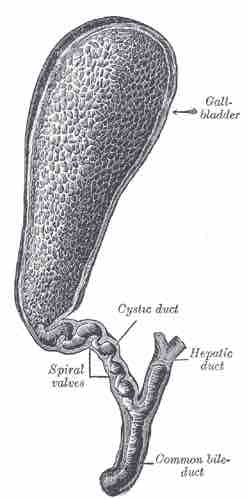The Gallbladder
The gallbladder is a pear-shaped organ that stores about 50 ml of the bile produced by the liver until the body needs it for digestion. It is about 7–10cm long in humans and is dark green in color.

Gallbladder
The gallbladder as depicted in Gray's Anatomy.
The gallbladder has a muscular wall that contracts in response to cholecystokinin, a peptide hormone that is synthesized by the small intestine.
Bile and the Gallbladder
When food containing fat enters the digestive tract, the secretion of cholecystokinin (CCK) is stimulated, and the gallbladder releases the bile into the small intestine. The bile emulsifies fats and neutralizes acids in partly digested food. After being stored in the gallbladder, the bile becomes more concentrated to increase its potency and intensify its effect in fats.